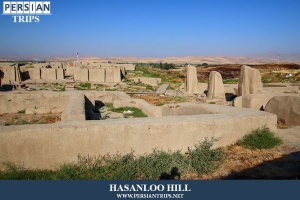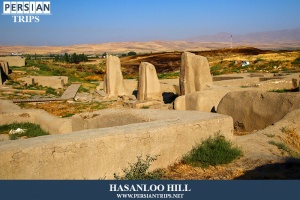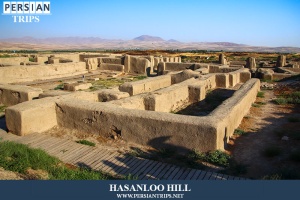Teppe Hasanlu

Teppe Hasanlu is one of the ancient hills of Iran that has unique historical monuments such as Hasanlu Golden bowl in its heart.
Teppe Hasanlu is the ancient remains of an ancient civilization on a hill located at a height of 20 meters, with an average diameter of 265 meters. The ancient Teppe Hasanlu is one of the most important historical heritages of West Azerbaijan province, which has many relics of long-held history of this region. This hill is only 12 km far from southwest of Lake Urmia and is located between the villages of Aminlu and Hasanlu. Hasanlu village is about 10 km away from Naghadeh city. Teppe Hasanlu is famous for its location near Hasanlu village. The site consists of two ancient hills formed by the accumulation of cultural materials over thousands of years of human civilization, with a history dating back to 6000 BC. The region included ten periods of settlement that lasted until the early 1300s.
The history of Teppe Hasanlu
The history of Teppe Hasanlu and its discovery dates back to 1934. Two years later, the English scientist "Sir Orlstein" discovered objects in Teppe Hasanlu through some excavations. Then, in 1947 and 1949, excavations were carried out on the hill.
Finally, in 1949, the Archeology Ministry began scientific excavations on this ancient hill. It should be noted that the objects which are displayed today in the National Museum of Iran from Teppe Hasanlu are the result of excavations in this period.
Finally, in 1958, the excavation team including Iranian and American archaeologists succeeded in discovering Hasanlu Gold Bowl. According to archeological data, this hill has been inhabited in 10 periods; fortunately, the thickness of the layers of each period is known and recognizable. The tenth period, which is considered to be the oldest period of Hasanlu settlement, belongs to the sixth to third millennium BC. This period begins from the ancient period and continues until the Medes and the Islamic period.
Hasanlu Gold Bowl is one of the prominent national antiquities that was discovered in Teppe Hasanlu in 1957 following the research of an American archeologist "Robert Dyson". The lifespan of Hasanlu Golden Bowl is estimated about 3200 years. There are engraved designs on this bowl as if it is a narrator of an epic story. This bowl, along with other artifacts discovered from Teppe Hasanlu, is kept in the National Museum of Iran.
There is a strong castle on this hill, in which some parts such as rooms, halls, and a defensive wall appeared during the excavations years ago. There is a wall with a diameter of three meters and a height of seven meters around the castle, and some square towers were built at a distance of 30 meters from each other and dimensions of 10 meters throughout this wall to protect the castle, but the height of the towers is not known. If we count one tower in every 30 meters, approximately the location of seven towers on the defensive wall of the castle can be identified; the position of the towers between the walls is so that three meters of the tower is inside the wall, five meters outside the wall and two meters on the other side.
Tags: West Azerbaijan Province, West Azerbaijan Attractions, Iran Historical Attractions, Teppe Hasanlu, Historical Hills in Iran


